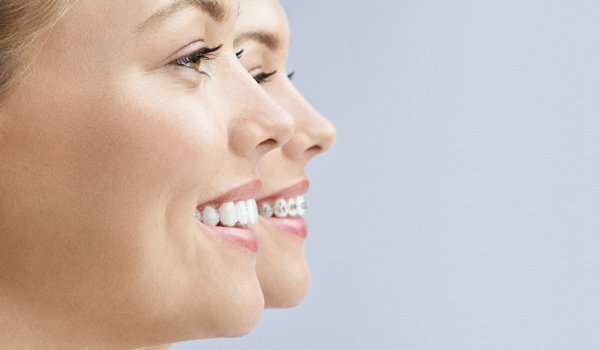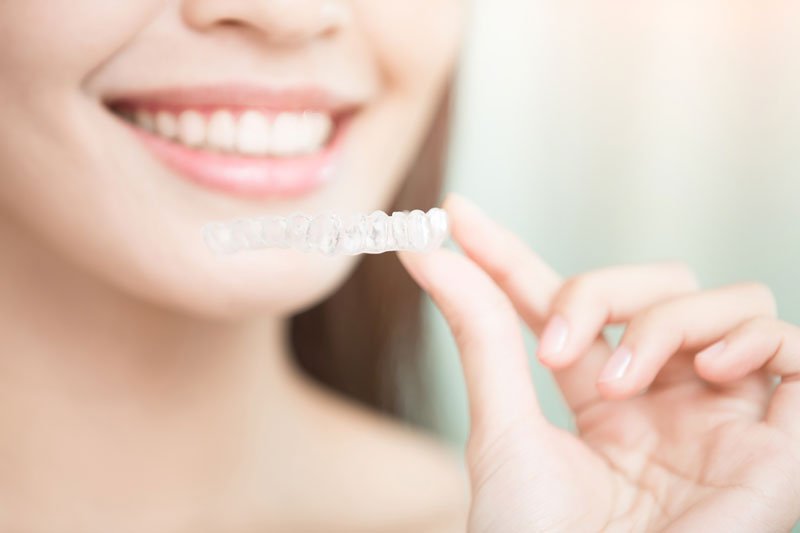Invisalign® FAQ
Invisalign® in recent years has become the treatment of choice for all ages. It is the world’s leading clear aligner system offering a discreet and hygienic treatment option.


Your Invisalign® Questions Answered
Will Invisalign® Work for Me?
Invisalign® can treat those 8 years old and up and address the majority of orthodontic problems. Of the already treated 6.4 million cases worldwide, 1.5 million are teenagers. For young children, our orthodontist provides early interceptive treatment when required to correct cross-bites. Occasionally a maxillary expansion appliance is required prior to Invisalign treatment if significant broadening of the palate is required.
Will Invisalign® Fix the Gaps in Teeth?
Absolutely! Invisalign® has advanced to the point it can now close entire tooth spaces in the majority of cases. This is exceptionally beneficial for those missing one or two premolars, as the space(s) can be closed to eliminate the time and cost associate with dental implants.
If you’re missing a tooth, we can often close space with Invisalign®! Not all spaces can be closed and there is so much taken into account such as the age of the individual, how dense the bone is, is there a history or bruxism or gum disease, how big is the space that needs to be closed, can the space be closed by moving the surrounding teeth on either side, or does the space need to be closed by only moving the back teeth forward? Have we lost you at how dense is the bone? There is so much that goes into planning, and we cannot stress enough that it is so important to select an experienced Invisalign® provider.
Will Invisalign® Fix My Overbite?
Absolutely! Invisalign® aligners are very effective at correcting overbites.
Will Invisalign® Fix My Gummy Smile?
Your teeth can move upward and can reduce a gummy smile. This needs to be done slowly for the gums to follow the teeth. If you want the teeth to move and to keep the gums in the same position, the the movement needs to be quick, which is called a “rapid ortho extrusion/intrusion”. So the speed and timing of movements are very important.
Invisalign® vs Braces?
Nowadays the time, cost, and results are all very similar between braces and Invisalign®. Invisalign aligners are more aesthetic and have the benefit of being removable for easy cleaning. Since they are easy to remove they also require compliance. The disadvantage of Invisalign® aligners is non-compliance. Those who suspect they will have trouble wearing the aligners (which can be any age), should consider braces.
How Invisalign® Works?
You will be provided with a series of aligners upfront and every one to two weeks the aligner is changed applying specific low-grade forces to the teeth to gently move them into the intended position. Many are unaware of additional procedures that are often required so Invisalign® aligners can work effectively, which includes tooth-coloured resin tags/attachments, elastics, buttons, Inter-proximal Reduction (IPR), and very occasionally the use of Temporary Anchorage Devices (TADs).
Do I Need Extractions with Invisalign®?
We support maintaining your teeth wherever possible, even if it means longer treatment. Extractions can change the facial profile/shape and can even reduce the lip support leading to a more obtuse nasolabial angle which creates a more prominent nasal profile and a smaller less supported lip. Many do not realise the effects teeth have on creating a harmonious facial shape.

Teeth support your lips and cheeks so you can imagine that if the upper teeth are too far forward or too far back the effects this will have on the upper lip (see photo). The underlying bony structure also supports the soft tissues, and these can be modified as well, with the majority of modifications being ideally completed during the teenage years during the growth peak.
Will Invisalign® Damage My Teeth?
There are always risks with any treatment, and this is why it is important to select an experienced provider. Moving teeth too quickly can cause root resorption and devitalisation. If teeth have pre-existing bone loss, the added pressures can result in loss of a tooth/teeth.
The largest issue with Invisalign® is from incorrect use of the aligners. Poor oral hygiene and a diet high in sugars or acid will inevitably lead to damage.
We do not recommend Invisalign® for those with moderate-severe gum disease, poor oral hygiene, or a high sugar/acid diet. These issues must be resolved prior to any form of orthodontic treatment.
While there are risks associated with Invisalign®, having an experienced provider greatly minimises such risks, and overall it is a very safe and effective method of straightening your teeth.
Will Invisalign® Hurt?
Some discomfort should be expected mainly on the first day of a new aligner and on the occasional morning. The severity of the pain is mild and can be managed by most individuals. It is recommended to insert the new aligner just before bed so you can sleep through the time the aligner feels the tightest.
How Long Will I Have to Wear Invisalign®?
The answer to this question is very individual and depends on the needed corrections. This can range from 7 weeks to over 2 years. The majority of cases take 12 – 18 months to complete. The aligners are worn for 20-22 hours a day.
Problems with Crooked Teeth?
Poorly positioned teeth can lead to tooth fractures/accelerated wear/headaches/difficulty chewing/speaking, and degeneration of the temporomandibular joint. The way the dental arches are shaped also have major implications on the function of the airway.
Invisalign® Planning
Most people come to us with the most obvious of concerns such as crowding/spacing, however we do not just fix the main concerns, most people tend to focus on the most obvious issue, however we take everything into account to create a beautiful and functional smile. The tips of the upper teeth should rest nicely on the lower lip on a “smile arch”. If the arch is too flat this gives an aged appearance and there will be a space between the teeth and the lower lip. There is so much more that goes into planning than just a couple of crooked teeth.
Invisalign® Teeth Aligners
Have you ever thought about straightening your teeth? How about changing the shape of the dental arches? Well you maybe considered straightening, yet few are aware that crowding or spacing is often a result of a misshapen dental arch. Those with crowded teeth for example often have narrow arches. A narrow arch sometimes restricts the space for the tongue to rest in the roof of the mouth, it can narrow the nasal passageway impeding breathing and create the need for mouth breathing. While most patients have an aesthetic concern, we also look at the functional issues. The shape of the dental arches impact the shape of the soft tissues of the face and the results can be dramatic improving overall appearance, function, speech, and even breathing.
We plan both functionally and aesthetically always considering the effects the changes in the dentition and dental arches will have on the soft tissues of the face. Extractions are exceptionally rare nowadays as this can create a lack of support for the upper lip and alter the facial profile.
Invisalign® in recent years has become the treatment of choice for all ages. It is the world’s leading clear aligner system offering a discreet and hygienic treatment option. The clear aligners are made with BPA-free plastic.
Invisalign® treatment times are on par with traditional braces. They are worn continuously during treatment and removed during eating for a minimum of 20 hours per day. The trays are replaced every one to two weeks to advance treatment.
